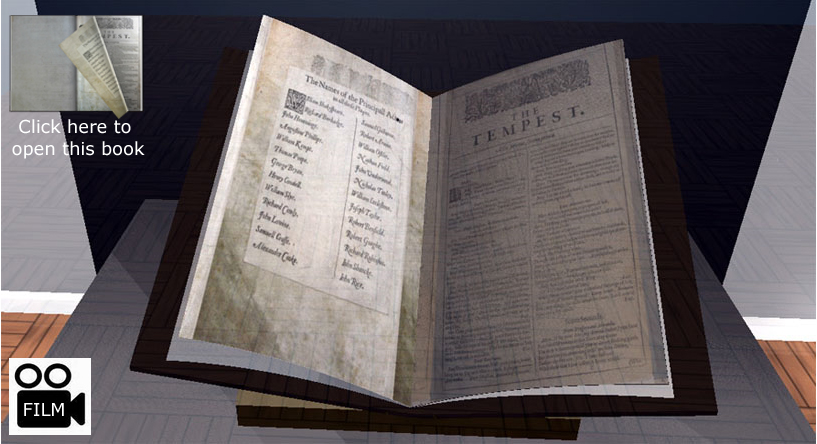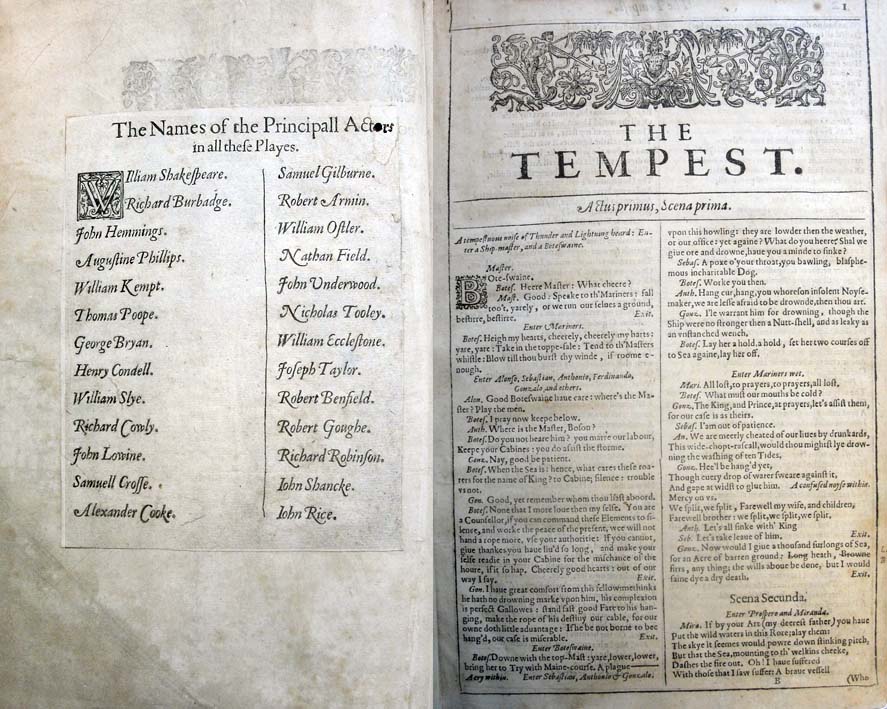William Shakespeare
Mr. William Shakespeares Comedies, Histories & Tragedies : The First Folio (1623)

 |
Click on the front cover of Wadham's First Folio (left) to read about the copy-specific features found inside our copy, which have been noted by Hertford College's Dr Emma Smith |
|
The men responsible for bringing this collection of thirty-six plays together were John Heminge and Henry Condell, senior actors of the King's Men (formerly the Chamberlain's Men), an acting company for whom Shakespeare had been writing and acting since 1594. Shakespeare had died in 1616 after twenty years with the company so Heminge and Condell had a working relationship with Shakespeare that allows them to present the folio as a personal tribute. It also provided them with their material; the folio claimed that the plays were 'published according to the true originall copies', presumably in the possession of the actors. The texts printed from the folio have a range of provenances: some are reprinted from quartos (smaller format books), others apparently taken from authorial papers or theatrical promptbooks which have not survived. There are almost twenty plays by Shakespeare, including The Tempest, Julius Caesar, Macbeth and Antony and Cleopatra, which we would not have at all if it were not for the first folio. Printing the folio was a huge publishing endeavour, with the cost and most of the work undertaken by a group of printers: William Jaggard and Isaac Jaggard, his son, Edward Blount, John Smethwick, and William Apsley. Wadham's first folio is slightly more crowded than it would have been when first printed because its pages have been trimmed at some point. Even without the trimming, though, the folio has very packed pages. One of the challenges with producing the folio was the availability of type and paper. The printers seem to have had to call in much of the type in London (you can see eleven different types- different fonts as it were- used in the folio). It was a major logistical endeavour to get enough type and to set it and also to pay for enough paper (which was expensive) so it was a huge investment for printers to take on this work. In 1616 Ben Jonson had arranged for the publication of his complete Works, the first time a collection of vernacular literature had been given the grandiose title 'Works' (Latin Opera) and using the grandiose folio format more associated with bibles and works of history and topography. Jonson's grand folio was an important precedent for the publication of Shakespeare's plays. Jonson had, though, also been mocked for the presumption or arrogance of publishing his collected works and not least for including plays as well as other, more serious or literary, forms of writing (poems, epigrams, masques). There are many differences between the two writers' folio works. While the Jonson folio had ordered the plays chronologically and even dated them, Heminge and Condell did not. Shakespeare's histories (which were all the plays of British history), are arranged chronologically by reign of king (rather than date of composition or performance as Jonson's had been). Jonson also included his poetry whereas Shakespeare's Venus and Adonis, Rape of Lucrece, and Sonnets were all left out of his Folio. The title of the folio is 'Mr. William Shakespeares Comedies, Histories & Tragedies', which perhaps avoids association with Jonson's 'Works'. The title also displays Shakespeare's dramatic range, and inside the collection the plays were organised according to the title categories of comedy, history and tragedy. These categories have stimulated centuries of discussion about the extent to which the plays fulfil the requirements of the genre or, more interestingly, how they flout perceived generic conventions. But Shakespeare himself probably did not consider his plays to fall into these three categories; they were decided upon by the producers of the folio, rather than Shakespeare. These genre categories also appear mutable; Richard II and III are listed as histories while their earlier publication in quarto had classed them tragedies. The first folio does not include Two Noble Kinsmen, Edward III, Sir Thomas More and Pericles (added in the third folio); these are all now thought to be at least partially by Shakespeare. Shakespeare's two narrative poems - Venus and Adonis and Lucrece - and his sonnets, are also not included. There might be various reasons for this omission. One reason might be that the folio, arranged by actors, focuses on Shakespeare as a playwright. In more practical terms, the texts of the plays were owned by the group who produced the folio. The poems, however, which had sold extremely well already, were owned by Roger Jackson and William Barrett (Venus and Adonis and Lucrece), and Thomas Thorpe for Shakespeare's Sonnets, who probably wanted to retain the rights to these lucrative publications. Who was the first folio for? Though this is a book produced by actors, they clearly meant it to have an audience beyond actors and theatre-goers. Indeed its high price, probably about a pound, would have confined its owners to the relatively wealthy. The dedication to William and Philip Herbert, earls of Pembroke and Montgomery, might also suggest that it was aimed at a courtly audience. As with the three other Shakespeare folios, this was bequeathed to the college by Richard Warner in 1775. There are at least 220 first folios in the world, almost a third of which are in the Folger Shakespeare Library in Washington DC. The folio's expensive format and status as a large book, probably kept in a library rather than carried around (like a quarto), probably helped such a significant number survive. |

|

|